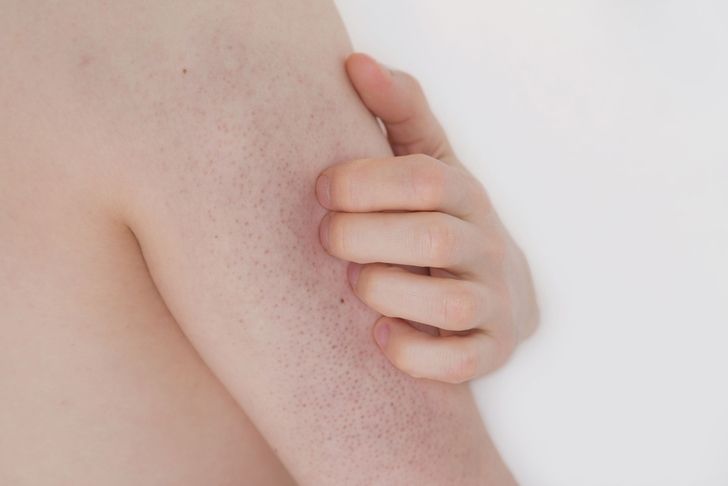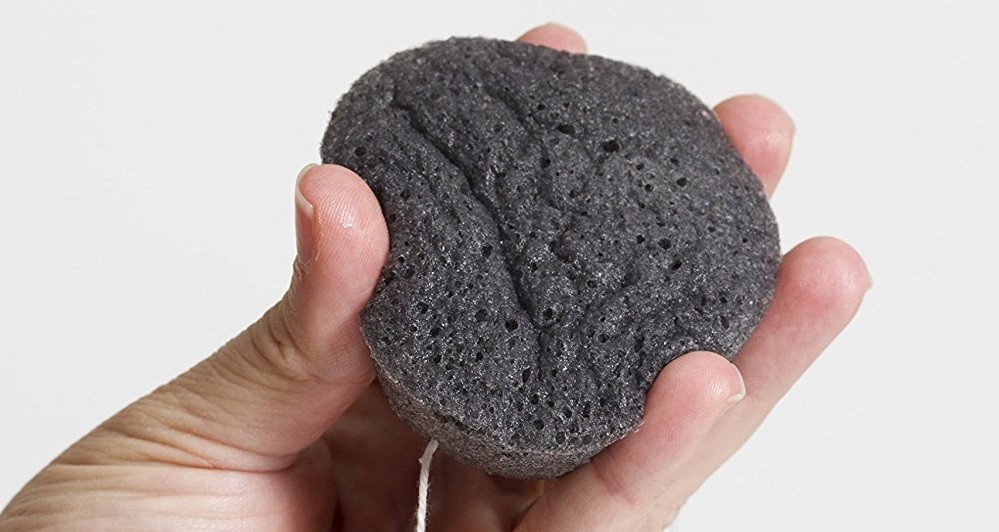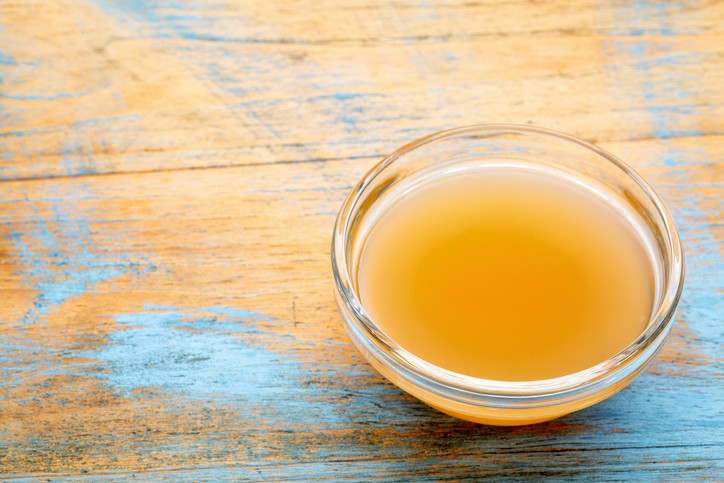
Keratosis pilaris appears like tiny bumps or brown spots on the skin, usually on the upper arms and legs.
It doesn’t normally cause any pain or discomfort unless the bumps get inflamed. Such red bumps are referred to as keratosis pilaris rubra faceii.
Although Keratosis pilaris is extremely common, many people don’t even realize that this condition has got a name in medical parlance.
Each bump is a hair follicle that got clogged by dead skin cells, often with a hair trapped inside.
If you scratch off a bump, you might see a thin, coil of hair, but avoid scratching the bumps since it can inflame the follicles and introduce pathogens that cause infection.
The exact reason of this skin disorder is not known, but dryness of skin seems to be a contributing factor.
Keratosis pilaris usually becomes worse during the drier months. Hormonal changes may have a role too, because it is more common during adolescence and pregnancy, and overweight women seem to be more prone to the condition.
Keratosis pilaris is generally considered a cosmetic problem rather than a serious skin disorder requiring medical intervention. But the roughness of the skin and its chicken skin-like appearance can be annoying.
Worrying about it doesn’t help, but it doesn’t go away if you ignore it either. There are several home remedies you can use to reduce this problem, if not cure it.
1. Exfoliation
Regular exfoliation is the simplest way to reduce the bumps. It removes the dead cells on the skin surface, including the extra pile over the follicles, opening them up and releasing the trapped hair, if any.
You can expect visible improvement within a few weeks, but exfoliation has to be done regularly to maintain the smooth feel of the skin.
Try a natural scrub – such as this Himalayan Salt Scrub – or make your own with one of these recipes.
2. Loofah or Sponge scrub

Every time you bathe, use a piece of natural sponge or loofah gourd to rub down the keratosis pilaris affected areas. A washcloth will do too, but if your skin is very sensitive, a konjac sponge may be a better choice. It is very gentle on the skin.
This set of konjac sponges is ideal – it includes five different sponges infused with skin-friendly ingredients like turmeric, charcoal and green tea.
Do not attempt to rub off the bumps at one go. It may irritate the skin and inflame the follicles. If you’re already using scrubs, you may need to use ones with a rougher texture to even out the bumps over several days. Apply a moisturizer after a bath to keep the skin hydrated.
Read Next: 6 Reasons You Need A Konjac Sponge For Your Beauty Routine
3. Oatmeal skin rub
- 2 Tbsp oatmeal crushed
- 2-3 Tbsp water/milk
Oatmeal is a gentle, skin-friendly scrub to smoothen out the bumps. Just mix with water or milk and apply on the affected areas. Rub it on with a circular motion for a few minutes and then wash off. This can be a messy affair, but it leaves your skin silky soft.
Alternately, you can bundle up some oatmeal in a muslin cloth and use it to rub down your body as you sit in the bath. Apply a moisturizer after washing off the oatmeal residue.
4. Olive oil skin rub
- 2 Tbsp olive oil
- 3 Tbsp table salt
Mix olive oil and table salt to make a slightly abrasive skin rub that can help you get rid of the bumps. Rub on the skin and massage for a few minutes before washing off with soap.
Repeat applications may be necessary, but it is a two-in-one operation where the salt does the exfoliation while the olive oil moisturizes the skin.
5. Coconut oil skin rub
- 2 Tbsp coconut oil
- 2 Tbsp granulated sugar/brown sugar
You can use coconut oil in place of olive oil. It may be semisolid as you make a paste with the sugar, but melts into a liquid with the heat from the skin. Rub on with a circular motion before or after a bath. Wipe off and rinse with water.
Coconut oil has anti-inflammatory properties that make it ideal for sensitive skin. It gets almost completely absorbed into the skin, so rinsing with plain water to remove the sugar crystals should be sufficient.
6. Baking soda and salt
- 2 Tbsp baking soda
- 2 tbsp table salt
Mix the two together adding just enough water to make a paste. Apply on keratosis pilaris affected area and leave for 5-10 minutes. Rub well and wash off. Repeat 3-4 times a week. Baking soda has a mild chemical, action while the salt provides the abrasive power.
7. Apple cider vinegar

- 3-4 Tbsp organic apple cider vinegar
Apply directly on the skin with a sponge or washcloth. Use a wet sponge to dilute the vinegar, if necessary.
Leave it on for about 10-15 minutes and wash off. The acidity of the vinegar acts as a chemical exfoliating agent, helping to gently peel away the excess skin cells plugging the follicles.
If the skin becomes too dry, use a moisturizing cream or a few drops of coconut oil.
Read Next: 5 Reasons To Wash Your Face With Apple Cider Vinegar
8. Yogurt
- 3-4 Tbsp yogurt
Apply on the affected area and allow to dry on the skin for 10-15 minutes. Wash off with a gentle soap. The lactic acid in the yogurt exfoliates the skin chemically. The milk fats may moisturize the skin.
9. Alpha Hydroxy Acids
These are organic acids with a mild to moderate exfoliating action depending on their concentration. Citric acid, lactic acid, malic acid, and glycolic acid come under this category.
Creams containing 10% alpha hydroxy acids can be applied to the skin without any adverse effects. This Nonie 10% Alpha Hydroxy Acid Moisturizer is ideal. Massage it in for best results. Wash off after 5 minutes.
If your skin is too sensitive, you can try lotions with 5% alpha hydroxy acids. This AHA Moisturizer contains 5% alpha hydroxy acids.
10. Vitamin A/retinol
- 1-2 capsules of Vitamin A
Vitamin A and its derivative retinol have proven skin benefits, especially in the treatment of acne. They can help remedy keratosis pilaris too, by regulating keratin production and preventing the follicles from getting plugged with dead cells. Vitamin A can reduce inflammation in case of keratosis pilaris rubra faceii.
Apply the contents of the Vitamin A capsules (such as these), rubbing it in with the fingertips. Wash off after 10-15 minutes. Avoid going out in the sun when you are using Vitamin A or retinol. They make the skin highly photosensitive.
11. Diet modifications
Since keratosis pilaris is worsened by skin dryness, keeping the skin hydrated from the inside with plenty of fresh vegetables and fruit can be beneficial. Drink plenty of water. Oily fish, nuts and other foods rich in omega 3 fatty acids may be of help too.
Keratosis pilaris has a genetic factor, so it may not be possible to cure the condition. But following a regular, yet gentle, exfoliating routine and keeping the skin moisturized at all times can definitely keep the unsightly bumps in check.
